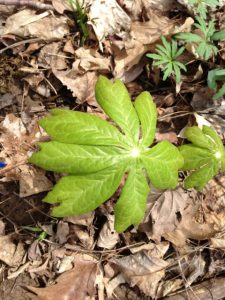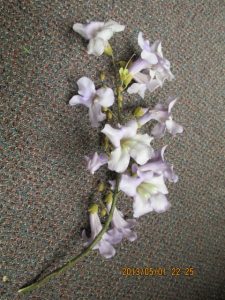Q. I have quite a few of these plants coming up in the wooded area behind my house. They seem to grow around trees, and there are large clusters of them. The clusters seem larger than I remember last year. What are these and are they poisonous and/or invasive? Should I try to control them?
A. This is the mayapple, aka mandrake, known botanically asPodophyllum peltatum. Mayapple is a lovely native woodland plant – no need to control. They do spread by rhizomes (underground stems) to form colonies. But their growing season is pretty short. Foliage (shown) comes up in mid spring. A single, white pendulous flower appears, usually in May, followed by a yellowish-green, fleshy ovoid berry (1-2 inches) that could resemble a small apple. The foliage dies back soon after.
All parts of the mayapple plant are toxic, except for the ripe flesh of the fruit, but the seeds contained in the flesh are also toxic, as is unripe fruit. You will find this plant listed in folk medicine publications; there is research showing potential for treating cancer, but this seems limited by possible toxicity. Consuming mayapple can be quite dangerous, even fatal. Best to enjoy this plant with your eyes. Additional information on this plant is available at www.ppdl.purdue.edu/ppdl/weeklypics/5-12-08.html and extension.psu.edu/plants/gardening/maescapes/articles/the-mayapple-a-spring-treasure.
Q. Can you tell me what kind of tree this is? There aren’t any leaves yet, just these flowers.
A. Those lovely flowers belong to the Royal Paulownia tree, sometimes called princess tree or empress tree. Known botanically as Paulownia tomentosa, this species is native to China but the large, heart-shaped leaves will remind you of our native Catalpa tree, a close relative. We don’t get to see this tree in bloom very often in most of Indiana. Paulownia produces its flower buds in summer for the following year, overwintering as brown, fuzzy buds, and blooming early in spring before the leaves break. In much of northern Indiana, Paulownia typically dies back to the ground each year. Roots survive and send up new shoots that show very impressive growth in just one growing season! But even where the tree is hardy, the flower buds are often winter killed. You’ll occasionally see it being advertised in newspaper and magazine supplements as a fast-growing tree, but it is not a particularly good selection for Indiana. Find more information at www.ppdl.purdue.edu/ppdl/weeklpics/11-11-02.html.

